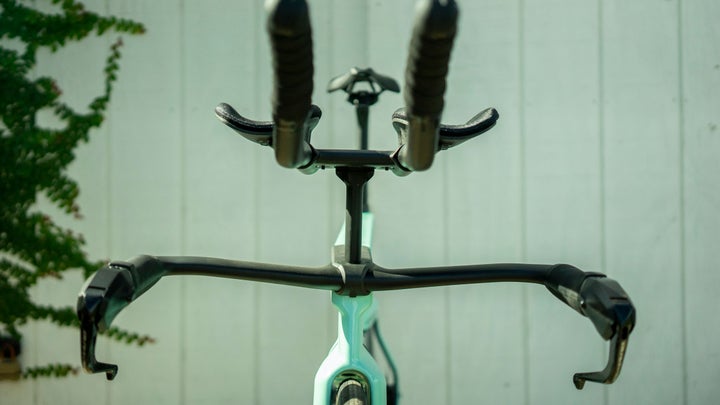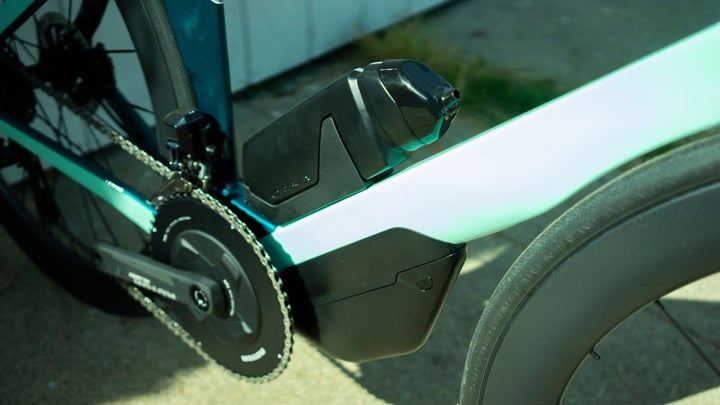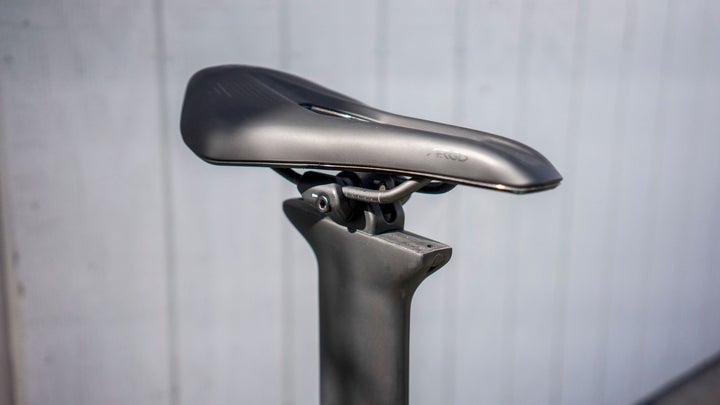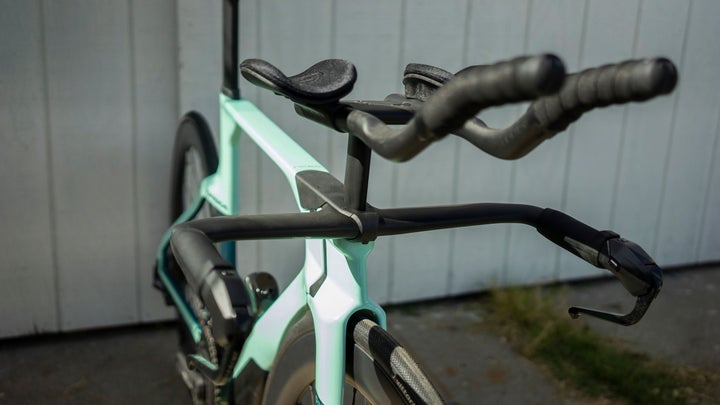New perk! Get after it with local recommendations just for you. Discover nearby events, routes out your door, and hidden gems when you sign up for the Local Running Drop.
It’s been a very very long time since Orbea released anything new. In fact, it’s been four years since Orbea made an update to the well-loved Ordu that had already been looking a little long in the tooth when it was revamped in 2016. Orbea made a calculated decision to not go the way of disc brakes (or an integrated front end) back then, and as such their Ordu looked a little dated during the past year or two. This was a shame for a brand that has always provided triathletes with an edgy and Euro alternative to the same old same old. But by 2019, the Ordu simply looked old. Enter the year we might all wish would have never existed: 2020. As Orbea’s production schedule had their new bike dropping square in the most un-triathlon year since 1973—landing on a Kona week that was not to be, no less—it’s unfortunate that such an exciting release happened in such a bummer of a season. That said, this is an exciting release, and it truly deserves our attention as something that could be a real thorn in a brand like Cervelo’s side.
RELATED: The Best Triathlon Bikes of 2021
Orbea Ordu Extended Review: The Build Rundown
While we’ve detailed the exact spec on this bike at the bottom of the review, below we’ve reviewed the important parts of the build that any triathlete looking to purchase this bike should think about, in order from most important to least:
- The fit is really The Thing on this bike, and while we’ll get to the specifics of that below, a lot of the fit’s flexibility is thanks to the monopost handlebar/aerobar setup and the seatpost. Expect to see a big range, thanks to these two highly mobile bits that can be adjusted very very easily. The front end and monopost bar system is fairly similar to Cervelo’s in that you can easily slide the entire aerobar setup up and down without the need for shims and bolts all over the place.

- The front end on this bike is exceptionally clean. And while we can’t attest to the aero savings (they claim a 11.5% total drag reduction over the last Ordu with a 41-second savings over an IM bike leg), the whole setup from the unique fork legs to the hinged head tube to the base bars and monopost really is a thing of beauty. Not all brands get this right.
- The pricepoint for this frameset is actually a pretty big deal. While I was fortunate enough to test the inscrutable named Ordu M10ILTD model with Dura Ace Di2 and carbon wheels that retails at $9k (which is actually not a bad deal), the fact that you can get this brand-new, super nice frame with hydraulic disc brakes and mechanical Ultegra for $5k is pretty impressive. A few quick comparisons: Even just the new Cervelo P5’s frameset alone costs $5,500 and Quintana Roo’s new PRsix2 Disc starts at $8,500. Sure, the latter comes with Ultegra Di2, but if you can’t afford to spend over $5k, you can’t get on that bike.
- Though I didn’t get a chance to go through the custom paint process, Orbea does offer a staggering amount of frame paint customization—thanks to the fact that they paint their bikes in-house in Spain. Purchasers have something like 23 color options for more than a few different spots on the bike, so you’ll get nearly endless options to customize. As for the stock paint? The “Ice Green Ocean” colorway has that deep pearl-flecked sparkle to it that usually only comes on really nice car paint jobs. It’s definitely best seen in person.

- This is not a bike that’s particularly high on the bells and whistles, but it does have a very cool storage area tucked under the downtube, just north of the bottom bracket where you can fit stuff like a flat kit and/or tools. The water bottle that comes with the Ordu is fine, but pretty much any triathlete is going to need to supplement that with either a between-the-bars hydration system or something that goes behind the seat rails (though exercise caution there, depending on how far forward you want your seat angle to go). A lot of this has to do with the fact that, for better or for worse, this bike is UCI legal.
Orbea Ordu Extended Review: The Fit
This is a big section because Orbea made a massive effort to focus on fit with the new Ordu. First, let’s look at the sizes: While Orbea boasts four sizes in their range (for comparison, QR has six in their PRSeries, Cervelo has five in their P5, and four for their PX-Series), in reality the two middle sizes are the same with only a higher max on the seatpost and front-end monopost on the M/L. So really, it’s more like three sizes. This seems like a bad thing, except that the front end and the seatpost actually boast a staggering amount of adjustment.

Due to a clever seatpost/seatpost clamp junction that can be bolted in three positions across the seatpost itself, you have 100mm of setback to play with. While you won’t be able to go ultra steep, given the size restrictions, you can still use the seatpost to give you 74-78 degrees of seat angle—about on par with tri bikes like the Felt IA or Shiv Disc, but not as deep as the Cervelo P-Series (75-79 degrees) or the crazy-steep Quintana Roo PRseries (77-83 degrees) and Ventum (75-82 degrees).

The big news on this Ordu is the front end’s flexibility for fit. Much like a few other superbikes, the base bar can be flipped, adding or subtracting 30mm to its height (bear in mind, this is NOT an easy procedure with hydraulic brakes, and you’ll likely need a bike shop to make the flip). The monopost that holds the aerobars and aerobar pads, on the other hand, is very easy to adjust, which is great as many triathletes often try to get lower as their strength/flexibility increases. On the XS and S/M sizes, the post has 90mm of stack range play; on the M/L and XL, the post has 140mm. Both setups allow for 15 degrees of tilt.
The armrests themselves have a decent amount of play, with 120mm of fore/aft for the reach—courtesy of a flippable bridge—and 90mm of adjustment for arm pad width. Here, we would have wanted more pad width options, as so many triathletes need wider arm pads, but it’s not the end of the world unless you’re very broad-shouldered. In fact, there are other arm pad options available in the aftermarket that will fit, but there’s no brackets to widen the pads themselves on this setup. The long and short of the Ordu’s fit is that while there are effectively only three different-sized frames, the range provided by the seatpost/front-end combo actually allows a lot of flexibility within those three sizes—without things getting “weird” with tons of spacers.
Orbea Ordu Extended Review: The Ride
While the numbers on paper all add up well for a wide range of fits, how does the thing ride? Pretty well, but not exactly what I thought it would be. First, expect a slightly bouncier ride than you’d expect from a high-end superbike. While it’s nowhere in the sub $5k, super-rough-ride realm, it lacks the buttery smoothness you’d find from some of the $7k-10k bikes with comparable race wheels. Slightly rougher than the P5 we keep referring to in this piece, but not something that’ll make you lose your fillings.
One of the other changes Orbea made to the Ordu is a longer frame reach per size, with the intention of helping stabilize handling. For sure you can feel that in corners—this Ordu sweeps more than it cuts, but it’s predictable, which is great for triathletes who don’t like to dive deep into corners (like on the Argon E-118 Tri+, for instance). It’ll go where you point it, but it won’t slice on a knife’s edge.
Handling-wise I’m wondering if the other reason Orbea chose to lengthen the top tube for stability to help with the front end while using the monopost in a high setting. As such, the bike felt quite twitchy while in the aerobars—my best guess is that this is due to the moderately high-and-forward front-end setup I ran. Though “twitchy” is not always a good thing, it certainly doesn’t mean unstable in this case, as the bike held lines equally well on flat sections at moderate speed and low crosswinds as it did on big fast downhills with lots of side breeze. In other words, it’s still a stable bike, but the aerobar-to-wheel feedback does take some getting used to—after a few rides it wasn’t even noticeable.
Finally, this was a bike with excellent power transfer from the pedals, both in the basebars (which can be set to a height that is not as savagely brutal as the aforementioned E-118 Tri+) and in the aerobars. It’s not as lightning quick as something like the P5, but it’s actually pretty close.
Orbea Ordu Extended Review: Conclusions
After so many years of having a bike that felt a little dated, Orbea proved that they spent that “time off” working on something very thoughtful. While the bike is missing the integrated hydration that other bikes in this category have (while trying to keep it UCI-legal, something Orbea will probably always do), it hits about 90% of everything else that triathletes need. The wide range of easily adjustable fit options cannot be overstated, even if there are only effectively three sizes of bikes. If anything, my best guess is that only three sizes do a lot to keep the cost of this frameset in the “moderately affordable” range—saving money on carbon molds and extra inventory is a great side effect of only having a few sizes.
This is a bike that’s a welcome addition to the current crop of disc-brake tri bikes above $5k. It’s certainly competitive at all of its models’ pricepoints, and it likely won’t need a lot of upgrading or changes as a triathlete ages, potentially develops issues that need to be addressed with an evolving fit, or looks to get a new set of inexpensive disc wheels. I would say this bike should be a strong contender for anyone shopping in this price range at any distance.
Orbea Ordu Specs (can be customized on purchase)
Ordu M20LTD ($5,000)
CRANKSET: Rotor VEGAST Aero 36x52t
HEADSET: FSA 1-1/8″-1″ Integrated Aluminium Cup
HANDLEBAR: Orbea Ordu OMX
EXTENSION: Vision Metron TFA Carbon Aero Clip-on JS-Bend
SHIFTERS: Shimano Bar End SL-BSR1
BRAKES: TRP T912 TT Hydraulic disc
CASSETTE: Shimano Ultegra R8000 11-28t 11-Speed
REAR DERAILLEUR: Shimano Ultegra R8000 SS
FRONT DERAILLEUR: Shimano Ultegra R8000
CHAIN: Shimano HG 701
WHEELS: Vision 55 SC Disc Carbon TLR CL
TIRES: Vittoria Rubino Pro IV G2.0 TLR 700x25c
SEATPOST: Orbea Ordu OMX
SADDLE: Fizik Argo Vento R5 size 140mm
HANDLEBAR PLUGS: Orbea Eva
FRONT WHEEL AXLE: Orbea Thru Axle 12x100mm M12x2 P1 Lite
REAR WHEEL AXLE: Orbea Thru Axle 12x142mm M12x2 P1 Lite
HYDRATION: Orbea Aero Bottle and Bottle cage Set
STORAGE: Aero Accessory Container
Ordu M20iLTD ($7,000)
CRANKSET: Rotor ALDHU Round 36x52t
HEADSET: FSA 1-1/8″-1″ Integrated Aluminium Cup
HANDLEBAR: Orbea Ordu OMX
EXTENSION: Vision Metron TFA Carbon Aero Clip-on JS-Bend
SHIFTERS: Shimano R9180
BRAKES: Shimano R9170 Hydraulic Disc
CASSETTE: Shimano Ultegra R8000 11-28t 11-Speed
REAR DERAILLEUR: Shimano Ultegra Di2 R8050 SS
FRONT DERAILLEUR: Shimano Ultegra Di2 R8050
CHAIN: Shimano HG 701
WHEELS: Vision 55 SC Disc Carbon TLR CL
TIRES: Vittoria Rubino Pro IV G2.0 TLR 700x25c
SEATPOST: Orbea Ordu OMX
SADDLE: Fizik Argo Vento R5 size 140mm
HANDLEBAR PLUGS: Orbea Eva
FRONT WHEEL AXLE: Orbea Thru Axle 12x100mm M12x2 P1 Lite
REAR WHEEL AXLE: Orbea Thru Axle 12x142mm M12x2 P1 Lite
HYDRATION: Orbea Aero Bottle and Bottle cage Set
STORAGE: Aero Accessory Container
Ordu M10iLTD ($9,000)
CRANKSET: Rotor ALDHU Round 36x52t
HEADSET: FSA 1-1/8″-1″ Integrated Aluminium Cup
HANDLEBAR: Orbea Ordu OMX
EXTENSION: Vision Metron TFA Carbon Aero Clip-on JS-Bend
SHIFTERS: Shimano R9180
BRAKES: Shimano R9170 Hydraulic Disc
CASSETTE: Shimano Dura-Ace R9100 11-28t 11-Speed
REAR DERAILLEUR: Shimano Dura-Ace 9150 Di2
FRONT DERAILLEUR: Shimano Dura-Ace 9150 Di2
CHAIN: Shimano HG 901
WHEELS: Vision 55 SC Disc Carbon TLR CL
TIRES: Vittoria Rubino Pro IV G2.0 TLR 700x25c
SEATPOST: Orbea Ordu OMX
SADDLE: Fizik Argo Vento R5 size 140mm
HANDLEBAR PLUGS: Orbea Eva
FRONT WHEEL AXLE: Orbea Thru Axle 12x100mm M12x2 P1 Lite
REAR WHEEL AXLE: Orbea Thru Axle 12x142mm M12x2 P1 Lite
HYDRATION: Orbea Aero Bottle and Bottle cage Set
STORAGE: Aero Accessory Container
